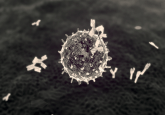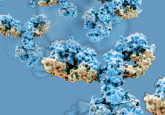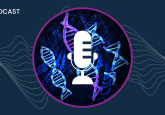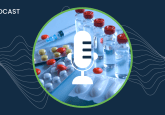The need for HRMS for quantitation of ADCs vs. QqQ: an interview with Megan Cooley
In this episode, we sat down with Megan Cooley, Associate Director of Bioanalytical Services at ICON, to explore the cutting-edge world of antibody-drug conjugate (ADC) quantitation using high-resolution mass spectrometry (HRMS). Megan delves into the capabilities of Triple Quadrupole and Time-of-Flight mass spectrometry, offering her expert insights into whether HRMS is essential for ADC PK studies. We also tackle the challenges and limitations of HRMS in ADC quantitation and discuss the potential for AI to create more specific and stable ADCs. Finally, Megan highlights ICON’s extensive experience with large molecule applications and their innovative approach to supporting complex LC–MS analyses.
Podcast transcript
[00:09] Emma Hall: Hello and welcome to our Spotlight Podcast episode on ADC Bioanalytics, sponsored by ICON. I’m your host, Emma Hall, and today I’m joined by Megan Cooley, the Associate Director of LC–MS Bioanalytical Services at ICON. Thank you so much for joining us, Megan.
[00:27] Megan Cooley: Absolutely. Thank you for having me.
[00:30] Emma Hall: Could you start by giving our listeners an overview of ADCs and their significance in drug development?
[00:36] Megan Cooley: Sure. So ADCs or antibody-drug conjugates are an added layer of targeted therapeutics called immunotherapies. Monoclonal antibodies (mAbs) alone were some of the first targeted therapeutics. Examples of this would be atezolizumab, PD-L1, or trastuzumab HER2. These therapeutics bind to their target on cancer cells, in this case, and inhibit [the] growth of the cancer cells. ADCs are conjugated to generally small molecules, or we might refer to them as payloads, to a mAb.
[01:10] The conjugation of the payload to the antibody is generally designed to not undergo cleavage until the target is reached. Generally, there is a pH change within the tumor microenvironment that can induce cleavage of the payload and ideally, this is incurring within the tumor cell itself causing cell death. This targeted therapeutic approach is intended to decrease cell death of non-cancerous cells as seen with traditional small molecule chemotherapeutics such as carboplatin or cisplatin. This limits, in most cases, the harsh side effects in patients who are undergoing treatments.
[01:47] It also limits the amount of toxin needed because it can be targeted to the cancer cells specifically. The emergence of ARCs or antibody-RNA conjugates is yet another advancement for immunotherapies. Instead of the traditional small molecule approach to cell death, generally through untargeted damage to DNA or downstream suppression of protein function, in this case, RNA or siRNAs target specific genes associated with cancer cell proliferation. As an example, although certainly not limited to only cancer cells, this turns off that specific gene inhibiting transcription of the protein level. And this is likely more advantageous for conjugated therapeutics.
[02:28] I think, though, beyond just the mechanism by which ADCs work from an analytical perspective, which is my background, there has to be the consideration for what sort of platforms we use for [the] quantitation of ADCs. I think, you know, specifically from an LC–MS perspective, currently there is quite a debate within the industry, in my opinion, as to if Triple Quad systems are sufficient for quantitation or if, you know, you need to have these high-res platforms to quantitate ADCs.
[03:05] Emma Hall: Amazing! Thank you, Megan. If we move on, what are the advantages of quantitating ADCs by LC–MS?
[03:14] Megan Cooley: So ADCs generally have four aspects for quantitation: total antibody, intact or conjugated antibody, conjugated payload and free payload. Historically, I would say that mass spectrometry has been used really to only quantitate free payload and assess the stability of the amount of free payload in the presence of the ADC to generate long-term stability data. But quantitation of ADCs using LC–MS can be extended to assess all aspects of these modalities that I mentioned previously, utilizing the same reagents that traditional ligand binding assays (LBAs) utilize.
[03:55] Although some reagents utilized for immunoprecipitation can be costly, LC–MS applications, in my opinion, are generally more rugged due to the selectivity of the mass spectrometer and reduced need to use secondary detection reagents that can cause variability in the assay performance due to lot-to-lot differences that may impact binding or specificity. In addition, LC–MS can be multiplexed to assess total or intact antibody and payload. This reduces the need to establish three out of the four assays since the chromatography developed for the payload can be used to assess both the conjugated and free concentrations.
[04:32] Emma Hall: Thanks, Megan. What are the common LC–MS platforms used for the quantitation of ADCs?
[04:38] Megan Cooley: So currently, there are two main platforms used for quantitation of ADCs: Triple Quadrupole Mass Spectrometers and Time-of-Flight, or in some cases, Triple Quadrupole Time-of-Flight Mass Spectrometers. With respect to ionization, both platforms can utilize electrospray ionization or atmospheric pressure chemical ionization. Electrospray ionization is the most widely used mechanism for generating ions into the gas phase. Large molecules, though, are difficult to ionize into the gas phase due to their size. Routinely, though, for these types of modalities such as ADCs, enzymatic digestion is employed in LC–MS applications to reduce the size of modality and length of a unique peptide sequence that we monitor to roughly 8–15 amino acids, which improves ionization efficiency and overall response.
[05:34] So the discrepancy between the two platforms though — that is Triple Quad and Time-of-Flight — occurs after ionization. So the Triple Quadrupole platforms depend on ions being filtered between the first and third quadrupoles and is based on a unit resolution. This means that they’re typically able to distinguish down to about 1 AMU (atomic mass unit) difference. Conversely though, Time-of-Flight uses distance or length of the flight tube to increase mass resolution. The rate at which the proteins — or digested peptide sequences — then travel through the flight tube, enables several isotopes to be easily distinguished. However, there is a sacrifice in this type of platform to response as fewer ions are collected for a given mass-to-charge at one time. This is reflected then in the overall lower response on this platform.
[06:31] Emma Hall: Is there a need for HRMS when quantitating ADCs for PK? And what are the limitations associated with HRMS for the quantitation of ADCs?
[06:43] Megan Cooley: Sure. So high-res mass spectrometry or HRMS does have a place with really any large molecule application. It’s not necessarily [a] quantitative space. That statement, though, is not intended to mean that quantitation is not possible with high-res mass spec platforms, but it is really intended to underline the function of this platform. In my opinion, high-resolution platforms, particularly Time-of-Flight-based platforms, are really an investigational tool.
[07:13] They’re useful to understand if there are structural changes that occur within the ADC over time. These types of changes can only really be assessed through intact mass analysis, which is not possible with Triple Quadrupoles. So high-res MS is also a useful tool then to understand if there are changes in the conjugation of the payload over time to the ADC. As a result of this insight, a lot of advances have been made to the chemistry used to conjugate payloads, creating more stable modalities.
[07:49] Then for the second part of the question, as we discussed earlier, there are sensitivity limitations with Time-of-Flight-based platforms. Based on the limitations around sensitivity for this platform and the argument to use it for quantitation of ADCs as opposed to Triple Quad mass spectrometers does, in my opinion, raise a question around the importance of sensitivity for the methodology that is required for ADCs. Historically, this has been a reason, that is the lack of sensitivity of LC–MS has been a reason as to why mass spectrometry has not been the preferred approach for [the] quantitation of ADCs.
[08:28] Routinely, though, in ICON’s experience, total antibody concentrations for ADCs have been between 20 and 50 nanograms per mL and this concentration range or detection limit really for the assay as well within the scope of Triple Quadrupole methods. In addition, Triple Quadrupole platforms have historically been used to quantitate picogram per mL levels of the free payload for ADCs. Again, though, if we’ve been using high-res mass spec platforms to better understand changes in the conjugation chemistry and we’ve improved these conjugation strategies, is there really then a need to assess such low levels of the payload even with these modalities?
[09:19] And I think that there’s an argument to say that there’s not, and that if you’re capable of achieving 10s of nanograms per mL or even 1 nanogram per mL, which you routinely see in small molecule applications, that this would be more than appropriate. And I say this too with thinking about these payloads that are conjugated to ADCs and that they, you know, again, have historically been small molecules. So I use MMAE (monomethyl auristatin E) as an example. The drug clearance for MMAE is well understood. Therefore, you know, again, if conjugation strategies have been improved so that off-target effects are minimized, is there really the need to even go so low in your detection limits with the free payload, or is it more just enough to understand that the molecule in and of itself is stable over time?
[10:19] Emma Hall: Perfect. Thanks, Megan. You’ve briefly touched on when it’s more appropriate to choose Triple Quad versus HRMS. But how common is biotransformation in ADCs to the point that you’d warrant HRMS?
[10:31] Megan Cooley: So this is a difficult question to answer and is largely dependent on the design of the antibody or in some cases, the associated payload. If perhaps the payload is not a small molecule, but instead a small interfering RNA or peptide, then biotransformation could be more common. If there’s little to no efficacy observed in preclinical or even first in human trials, then a method that could quickly be established to assess modifications to the ADC and patient samples would be quite beneficial. But, again, this is not an application where we’d be assessing PK. But high-res mass spec, again, comes through in this instance as an investigational tool that can be used to understand perhaps the lack of efficacy that you are seeing that could then be traced back to a biotransformation.
[11:30] Emma Hall: Is knowing only an average drug-to-antibody ratio value problematic for quantitation of ADCs? Do we care if we know we have two payloads versus four payloads? And if so, do we need high-resolution mass spectrometry, i.e. Time-of-Flight, to determine the value?
[11:46] Megan Cooley: Sure. So drug-to-antibody ratio or DAR is determined by measuring the concentration of the drug divided by the total concentration of the antibody. This measurement is important to understand the number of payloads that are conjugated to the mAb over time. However, the heterogeneous nature of ADCs from a manufacturing standpoint makes it challenging to report just a single DAR value. Therefore, the average number of drugs conjugated to an antibody is generally reported. This term is then expressed as average DAR [and] has been widely used in LBAs and also to some extent in LC–MS assays.
[12:33] But I think it’s important to just take a minute and understand, you know, what each of these platforms is actually capable of providing whenever it comes to this average DAR value. So, ligand binding approaches depend on the ability of the capture or detection reagent to bind the target of interest, but the detection mechanism for this approach is spectroscopy-based. So in this instance, there [are] no molecular characteristics that are understood from the detector used in the detector, and so you just have a relative number of photons that are reaching the detector at a given time.
[13:16] So with LBAs, there also is no orthogonal means to actually separate the antibody that has two payloads that are conjugated to it versus eight payloads that are conjugated to this. So, really, this technique gives a relative number of payloads for an ADC at a given time. Mass spectrometry, though, on the other hand, can determine more definitively the exact number of payloads that are conjugated to an antibody due to the specificity of the technique. That is to say the mass-to-charge value associated with each complex compared to spectroscopy-based approaches.
[14:01] Additionally, there is the added specificity with LC–MS that can be achieved with separation of different DAR species prior to detection. Again, we’re going to look collectively though at the summation of each of these species in a given analysis and report an average DAR and then assess that average DAR value over time to get a picture of [the] stability of these ADCs.
[14:32] So with respect to the latter part of the question, we do have to ask, you know, what is the critical nature of knowing the exact number of payloads conjugated to an antibody? So we’ve distinguished that we can’t really know the exact value of the drug-to-antibody ratio. But obviously, in either case, ligand binding or mass spectrometry reporting the average, the average DAR value, it’s just the information that we can observe with mass spectrometry, in my opinion, is far greater. So then there can be adverse immune responses that are associated with the antibody as a part of the ADC, but there is still the concern of toxicity with the payload. This is impactful.
[15:22] So, again, you know, we do need to understand at least the average value of DAR. But then we also, in my opinion, need to have solid characterization of the modality with respect to [the] stability of the conjugate and targeted confirmation of the therapeutic as well. So these aspects of ADCs in particular, in my opinion, while they complement understanding the DAR value at any one given time, the critical nature of the characterization of these compounds outside of PK assessments is really more important. And this though should be addressed as a part of more of the manufacturing process than something downstream in bioanalysis.
[16:20] Emma Hall: Amazing! Thank you so much. If we now move on to looking more towards the future, does AI have a space in limiting the need for HRMS in applications for ADCs?
[16:30] Megan Cooley: So AI has vast potential in many different fronts within the pharmaceutical industry from decreasing method development time to creating more efficient reporting or data review processes. And I feel like this is especially important in contract research organizations like ICON. So with respect to ADCs, it could be useful to support modeling or improved insight into downstream biotransformations that might occur endogenously or potentially support development of better antibody design to minimize off-target effects.
[17:10] The downfall, though, of course, with this or these thoughts is that this information exchange that occurs, occurs through an open source environment, which has limited appeal definitely for the pharmaceutical industry due to the proprietary nature of these modalities. So I think that that really limits, you know, taking your sequence of your mAb and inputting it into these systems. But with that said, AI could be used to perhaps improve modeling programs that could then be used to create more specific and stable ADCs based on their target information. Target information, of course, is likely available already on a number of different databases that are publicly available.
[18:03] Emma Hall: Great. Thanks, Megan. I have a couple more questions for you. Firstly, in your opinion, what is the future for ADCs in LC–MS?
[18:13] Megan Cooley: So with respect to LC–MS capabilities to support quantitation of ADCs more routinely in the immediate future, I think that there needs to just be a continued push for more sensitive instrumentation, as well as instrumentation that continues to improve mass resolution. So Thermo [Fisher] Scientific (MA, USA) has continued, in my opinion, to kind of push these boundaries with the evolution of their Orbitrap line. I think these tools could be very useful for, honestly, any large molecule application aside just from specifically ADCs. Additionally, I think LC–MS can still be considered an expensive technique for ADC applications. This is commonly just because of the use of magnetic beads as a part of immunoprecipitation approaches that adds significant cost per sample.
[19:11] For these approaches, even if you’re doing immunoprecipitation, you could still evaluate plate-based captures that could be used to reduce [the] overall cost of the assay. Obviously, plate-based captures are commonly used in LBAs, so this is still a very effective way to reduce matrix interference. However, I think that this type of approach needs to be evaluated on a case-by-case basis as, in my opinion, there is quite a difference in surface area between the magnetic beads and the traditional ligand binding plates that can contribute to [the] overall reduced sensitivity of the assay. And when you’re already fighting that stigma of not having enough sensitivity in LC–MS, I think that that can just add to it. But it is a way that you could reduce cost.
[20:10] Emma Hall: Yes, absolutely. Thank you. What has ICON’s experience been with large molecule applications, and how do we think we can contribute to support more complex application for large molecules with LC–MS?
[20:23] Megan Cooley: ICON has had significant experience in large molecule applications in general with over 10+ years of experience in this field. We focus on a wide range of modalities, so, again, not just ADCs, but for example, quantitation of monoclonals by themselves, bispecifics, modified proteins, modified siRNAs, protein biomarkers and ADAs, just to name a few. These have resulted in numerous publications in peer-reviewed journals and presentations at conferences on a global scale. In addition, we are, in my opinion, unique amongst several contract research organizations due to our scientific staff affiliation within university settings. This enables us to participate in discovery-based research, broadening our knowledge base for clients who come to us with complex issues.
[21:18] Emma Hall: Amazing! Thank you very much for sharing your experience and insights with us, Megan. For our listeners, you can find more resources on ADC Bioanalytics on our Spotlight homepage. Thank you again for joining us.
About the Speaker:
 Megan Cooley
Megan Cooley
Associate Director of Bioanalytical Services
ICON
Megan Cooley is Associate Director of Bioanalytical Services at ICON. Her field of expertise includes LC–MS and LC and CE with electrochemical detection. Megan has worked in the pharmaceutical industry as a bioanalytical scientist in clinical project teams for 7 years. She supports the LC–MS operational science teams in ICON’s laboratories located in Lenexa (KS, USA). She holds a Doctorate degree in Bioanalytical Chemistry from the University of Kansas (KS, USA)
Enjoy this podcast? Explore the full Spotlight feature on ADC bioanalytics here.
This feature was produced in association with:






